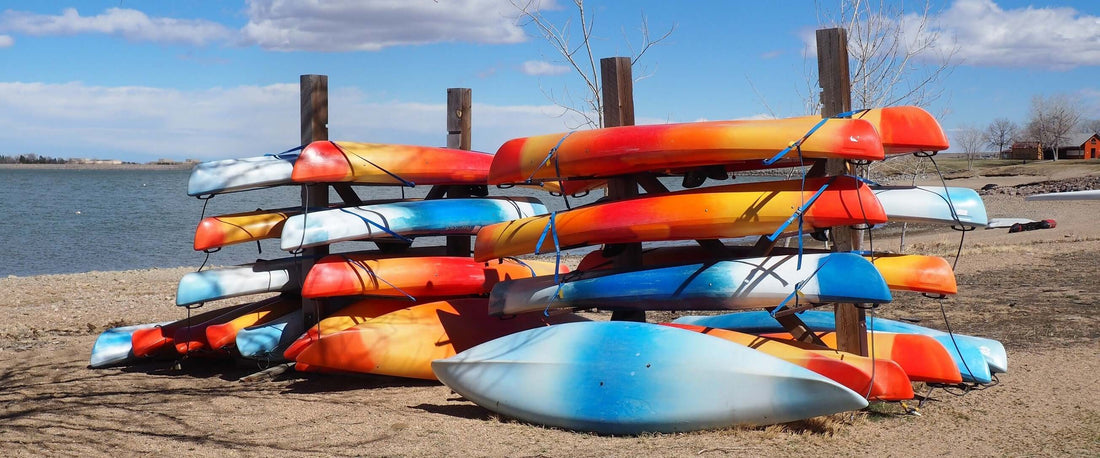We can’t all live in a tropical paradise with year-round sun, clear blue skies, and sparkling clear water. To those that do, kudos to you. For the rest of us (who must endure gray skies, plunging temperatures, and frozen waterways) - preparing our kayaks for the off-season is important.
So, how should you maintain your kayak when the mercury starts to plunge. Here are some things to consider for maintaining your kayak in the off-season.
Clean Your Kayak
First, make sure that your kayak is clean. While it is always a good idea to give your kayak a nice rinse after every outing, it is important to take a little extra care before a season off.
Make sure to remove all accessories, equipment, and removable pieces. Use a mild soap, sponge, and water to remove any stains, built up dirt, salt water, algae, etc. Make sure to wash inside and out. This might require you to actually get into the hull to wipe things down completely. Pay special attention to rims/overlaps/seams, hatch covers, tracks, and holders to make sure they haven’t accumulated sand, crud, and dirt.
Also give a good cleaning to those accessories like paddles, spray skirt, bilge pump, float bags, and other equipment. If you have a removable seat, it is important to remove and clean under and around that as well.
Make sure that the kayak dries completely. Don’t let any water sit inside the hull.
Inspect / Update / Repair Your Kayak
This is a great time to inspect your yak and make any necessary repairs and updates. As you are cleaning, take notes.
- Is your hull in good shape? Dents or problem areas that can be corrected now and not spring a leak in the middle of a paddle?
- How is your paddle? Is it in good working order? Are rudder, pedals, and outriggers still doing the job?
- Are any lines frayed? How are the handles and bungees and other rigging?
- Are the tracks free of debris and caked in dirt? Are they functional?
- What about your battery-operated, solar-powered, or motor powered equipment? Is it all in working order?
Now is a great time to make any necessary repairs and updates. You can get a repair kit for plastic/composite and fiberglass kayaks if you have deficiencies in your hull. You can also use a polishing compound on superficial blemishes. Order replacement parts or upgrade if necessary.
In addition, you will want to update or replace any expired items in your first aid kit. (Or toss them for the off-season and prepare to restock in the spring.) And, not but not least, check that your PFD looks good - no tears, weakened or missing hardware, etc.
Protect Your Kayak
Both plastic and fiberglass kayaks are susceptible to UV rays which can cause them to become faded and brittle. One way to migate this problem is to use a protective spray or wax.
There are a number of different UV protectants that you can buy to fight the effects of harmful sunlight on your plastic. Spray both the outside and inside your kayak with a thin layer. Then, wipe to a shine with a paper towel. In addition to providing UV protection, these sprays often provide water repellency. Especially during the paddling season, you will be able to know when it is time to re-apply as the water will stop beading and rolling off.
A fiberglass kayak benefits from a fiber-glass suitable wax to protect the finish.
You might want to consider oiling any metal parts as well - especially if the kayak will be unused for a considerable amount of time.
Correctly Store Your Kayak
Now you are ready to store your kayak for a few months of winter hibernation.
- First, make sure that it is completely dry. Any water left on the kayak could potentially freeze and contract causing damage or lead to the growth of mold/mildew.
- Second, make sure that the cockpit of a sit-in kayak is completely covered. (This ensures that your kayak stays critter-free.)
- Third, choose your storage location. Indoor storage (garage, shed, spare room) is definitely preferred. If possible, keep the kayak away from windows which expose it to UV damage and heat sources that can damage it. If you are storing outside, consider how to keep your kayak from view, shaded from the sun/heat (under a tarp/kayak cover or in a shady area), and off the ground if possible.
- Fourth, place it so the hull is protected. The hull of your kayak shouldn’t bear weight for a long period of time. Decide if you can store your kayak vertically or store it horizontally. Then you can find hooks, frames, suspension system, etc to help to keep the kayak hull side up or unrestricted.
- Fifth, if you are storing outside and are using a tarp, make sure that you use the tarp like a tent. Rather than wrap the kayak in the tarp, set the kayak under the tarp so that air is able to circulate and reduce moisture build up.
Take care of your investment and store your kayak properly. You will be grateful for the work when the days begin to warm and you can quickly take advantage of getting your well-maintained kayak out on the water.

